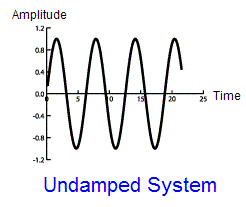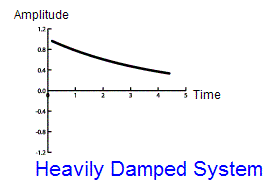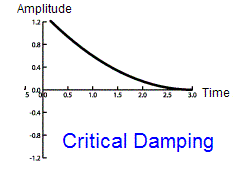|
Any completely isolated
system exhibiting simple harmonic motion will carry on swinging/vibrating
for ever! It conserves mechanical energy. There will be continuous interchange
of kinetic to potential energy and back again.
For example,
In a spring-mass system,
the the energy conversion is between kinetic energy and the potential
energy stored in a stretched/compressed spring.
In a pendulum, the energy is converted between kinetic energy and gravitational
potential energy.
BUT in the real world it is impossible to isolate the system - friction with supports and surrounding
air molecules drains energy from the swinging/bouncing system into the
environment - the total mechanical energy left in the system therefore
gradually decreases.
Energy is still conserved! BUT energy within the
system is being drained to another place.
Damping is the term
used to describe a means by which energy drain from the oscillating system
can be occomplished. Remember 'damping' is just a euphemism for frictional
forces like air-resistance. Once there is 'damping', the system is no
longer conservative.
SHM systems under damping
Damping
changes the behaviour of S.H.M. systems. Certain features of the oscillation
(amplitude etc.) are dependent on the extent of damping.
 |
An
undamped system gives `normal' S.H.M. - a sinusoidal trace
- with constant amplitude - no energy transfer out of the sytem
|
|
In
a lightly-damped system, the amplitude of oscillation decreases
slowly as time goes on. An example of such a system would be a pendulum
in a clock - air resistance causes the swing's amplitude to decrease
with time. the system suffers a steady drain of energy.
|
 |
 |
A
heavily-damped system moves slowly until coming to rest.
It does not oscillate but the governing equations are still the
same. A spring-mass system immersed in a bath of very viscous liquid
would be heavily-damped. Energy is drained from the system so that
it takes longer to reach zero.
|
|
Critical
damping causes a system's amplitude to reach zero (and stay
there) in the shortest time possible. Shock absorbers on cars are
critically damped.
|
 |
(Also see resonance)
|




 Damping
Damping 




